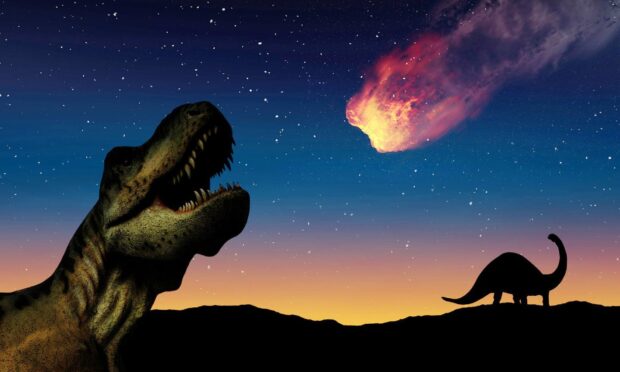By analysing ancient rocks, scientists from Aberdeen University have helped to uncover the mystery of what happened to the dinosaurs.
Geoscientists from the UK, Mexico and Brazil have teamed up to help shine a light on a meteorite event that wiped out Earth’s dinosaurs.
The study, co-authored by Professor Ben Kneller from Aberdeen University, analysed rocks dating to the time of the meteorite event.
Thought to have hit Earth over 66 million years ago, the meteorite ignited forest wildfires up to thousands of kilometres from the crash site.
It struck the Yucatan peninsula in what is now Mexico and wiped out more than 75% of living species.
Paints vivid picture of the aftermath of the meteorite strike
There is a lot of uncertainty surrounded the event but due to the study, geoscientists were able to discover that the fire broke out within minutes and had an impact of 2,500km.
However, the wildfires that broke out were short-lived as the impact also caused a tsunami which doused the flames.
Professor Kneller, a professor at the School of Geosciences at Aberdeen University, said: “What triggered these forest wildfires and their extent and timing have been debated for quite a while.
“Until now it has not been clear whether the fires were caused as a direct result of the impact or subsequently, as vegetation killed by the post-impact darkness caused by the debris thrown up into the atmosphere was set ablaze by things such as lightning strikes.”
Scientists from Autonomous University of Mexico, Federal University of Rio Grande do Sul, University of Leeds and University of Manchester were also included in the study which was run by Shell Brazil.
The international team were able to apply a unique combination of techniques to confirm they were analysing rocks from the date of the impact.
He added: “We then analysed fossilised bark still attached to the tree trunks to determine the extent of the burning, finding that the bark was already charred as the trees were washed away by the impact-related tsunami.
“This shows that the fires must have begun within minutes, at most, of impact.
“Ultimately our research confirms how and when these devastating fires were begun and paints a vivid and quite terrifying picture of what happened in the immediate aftermath of the meteorite strike.”


Conversation